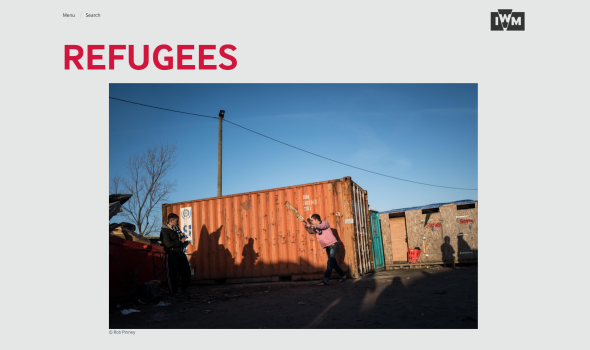Refugees: ‘It can happen to anyone’
Refugees: ‘It can happen to anyone’

One of the hardest tasks in staging a large season such as Refugees at the Imperial War Museum is ensuring that it is not outdated by events.
A feature of the season is Life in a Camp, an installation created with CNN that uses three large wall projections to offer an intimate view of the makeshift Moria camp on the Greek Island of Lesbos. Designed to host 2,200 people, says the exhibition publicity, Moria became home to more than 18,000 refugees.
But in September a fire destroyed the camp, and the exhibit changed from present to past tense - though remains highly relevant.
CNN filmmaker and photojournalist Lewis Whyld returned to the camp in September to capture footage in the wake of the fire. This up-to-the-minute footage has been incorporated in the installation, and the wall text updated:
“In September 2020 a fire destroyed large sections of the camp, leaving more than 12,000 people without shelter. People are now sleeping out in the open, with no access to basic supplies, and nowhere else to go.”
Similarly, statistics about refugees used in the exhibition Refugees: Forced to Flee changed during lockdown as the UN reported a near doubling of refugees from 10.4 million to 20.2 million.
Most of the exhibition, however, remains as planned because it is looking at refugee issues over the last 100 years, rather than just the last 100 days.
One of the basic ideas behind it, says curator Simon Offord, is that "refugees are simply ordinary people in extraordinary circumstances".
"It can happen to anyone," he points out. "In World War Two tens of thousands of British people went abroad, many to Canada and Australia." They were refugees, too, part of the biggest mass movement of people in British history, according to the BBC History website.
The exhibition also makes it clear that refugees have always been on the move, often in large numbers, and sometimes forgotten in the public memory. About 250,000 Belgians moved to the UK as a result of the First World War, 100,000 of them in London - "yet the only thing people here now know about Belgians is Hercule Poirot [a fictional detective created by Agatha Christie]", says Offord.
The causes of conflicts from which refugees flee may be different, he says, "but what is common, which we have tried to focus on, is the experience of being forced from home, making a sometimes dangerous journey, finding a temporary shelter, facing bureaucracy and barriers, finding a place to settle, learning a new language, finding a job.
"These things are universal across time and space. The concept of home runs through the exhibition."
As well as the Moria camp video, there's an installation on bombs by Chinese artist and activist Ai Weiwei and A Face To Open Doors, an interactive experience where "you will meet a border guard driven by artificial intelligence. Your face is your passport. How you use it during your meeting will inform where you are sent." But the heart of the season are the photographs, films, animations, oral histories, documents, objects and other material, some dug out of the museum's archives and on show for the first time, and some based on outside research "that has provided the exhibition with unparalleled resources to tell stories of refugees across the world."
"We've tried to make it experiential," says Offord. "It's very much a visual thing," with soundscapes and lighting effects to make each part of a refugee's journey seem different.
"Now more than ever it’s important for IWM to bring 100 years of refugee voices and experiences back to the forefront,” he says.
+ Refugees: Forced to Flee + Life In A Camp + A Face To Open Doors + Ai Wei Wei History of Bombs, free, are at the Imperial War Museum London, Lambeth Road, SE1, until 24 May 2021.


